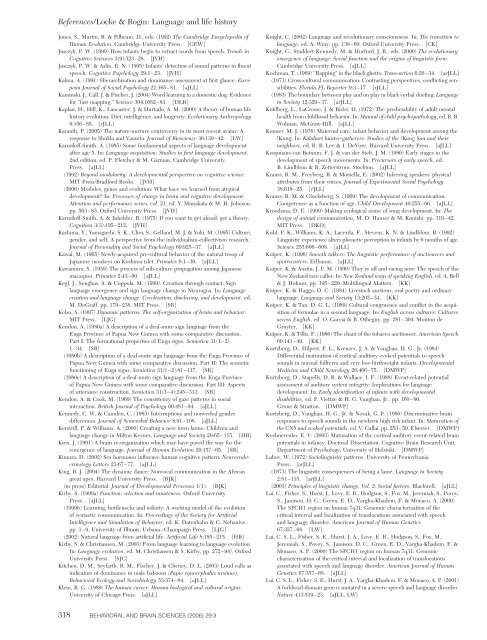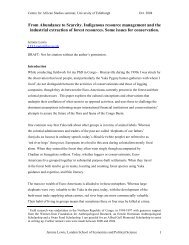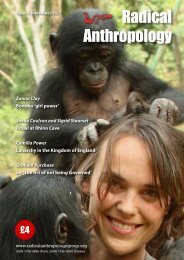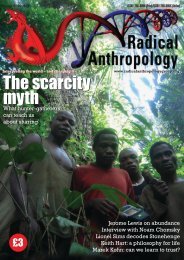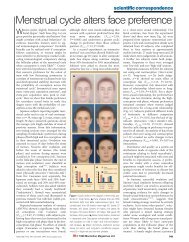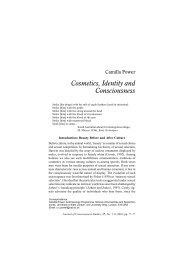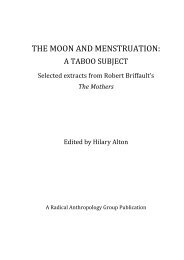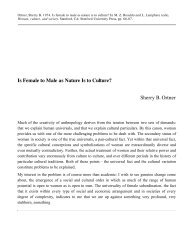Language and life history: A new perspective on the development ...
Language and life history: A new perspective on the development ...
Language and life history: A new perspective on the development ...
- No tags were found...
Create successful ePaper yourself
Turn your PDF publications into a flip-book with our unique Google optimized e-Paper software.
References/Locke & Bogin: <str<strong>on</strong>g>Language</str<strong>on</strong>g> <str<strong>on</strong>g>and</str<strong>on</strong>g> <str<strong>on</strong>g>life</str<strong>on</strong>g> <str<strong>on</strong>g>history</str<strong>on</strong>g>J<strong>on</strong>es, S., Martin, R. & Pilbeam, D., eds. (1992) The Cambridge Encyclopedia ofHuman Evoluti<strong>on</strong>. Cambridge University Press. [GEW]Jusczyk, P. W. (1999) How infants begin to extract words from speech. Trends inCognitive Sciences 3(9):323–28. [JVH]Jusczyk, P. W. & Aslin, R. N. (1995) Infants’ detecti<strong>on</strong> of sound patterns in fluentspeech. Cognitive Psychology 29:1–23. [JVH]Kalma, A. (1991) Hierarchisati<strong>on</strong> <str<strong>on</strong>g>and</str<strong>on</strong>g> dominance assessment at first glance. EuropeanJournal of Social Psychology 21:165–81. [aJLL]Kaminski, J., Call, J. & Fischer, J. (2004) Word learning in a domestic dog: Evidencefor “fast mapping.” Science 304:1682–83. [DLB]Kaplan, H., Hill, K., Lancaster, J. & Hurtado, A. M. (2000) A <strong>the</strong>ory of human <str<strong>on</strong>g>life</str<strong>on</strong>g><str<strong>on</strong>g>history</str<strong>on</strong>g> evoluti<strong>on</strong>: Diet, intelligence, <str<strong>on</strong>g>and</str<strong>on</strong>g> l<strong>on</strong>gevity. Evoluti<strong>on</strong>ary Anthropology9:156–85. [rJLL]Karanth, P. (2005) The nature-nurture c<strong>on</strong>troversy in its most recent avatar: Aresp<strong>on</strong>se to Shukla <str<strong>on</strong>g>and</str<strong>on</strong>g> Vasanta. Journal of Bioscience 30:139–42. [LW]Karmiloff-Smith, A. (1985) Some fundamental aspects of language <strong>development</strong>after age 5. In: <str<strong>on</strong>g>Language</str<strong>on</strong>g> acquisiti<strong>on</strong>: Studies in first language <strong>development</strong>,2nd editi<strong>on</strong>, ed. P. Fletcher & M. Garman. Cambridge UniversityPress. [aJLL](1992) Bey<strong>on</strong>d modularity: A <strong>development</strong>al <str<strong>on</strong>g>perspective</str<strong>on</strong>g> <strong>on</strong> cognitive science.MIT Press/Bradford Books. [JVH](2006) Modules, genes <str<strong>on</strong>g>and</str<strong>on</strong>g> evoluti<strong>on</strong>: What have we learned from atypical<strong>development</strong>? In: Processes of change in brain <str<strong>on</strong>g>and</str<strong>on</strong>g> cognitive <strong>development</strong>:Attenti<strong>on</strong> <str<strong>on</strong>g>and</str<strong>on</strong>g> performance series, vol. 21, ed. Y. Munakata & M. H. Johns<strong>on</strong>.pp. 563–83. Oxford University Press. [JVH]Karmiloff-Smith, A. & Inhelder, B. (1975) If you want to get ahead, get a <strong>the</strong>ory.Cogniti<strong>on</strong> 3(3):195–212. [JVH]Kashima, Y., Yamaguchi, S. K., Choi, S., Gelf<str<strong>on</strong>g>and</str<strong>on</strong>g>, M. J. & Yuki, M. (1995) Culture,gender, <str<strong>on</strong>g>and</str<strong>on</strong>g> self: A <str<strong>on</strong>g>perspective</str<strong>on</strong>g> from <strong>the</strong> individualism-collectivism research.Journal of Pers<strong>on</strong>ality <str<strong>on</strong>g>and</str<strong>on</strong>g> Social Psychology 69:925–37. [aJLL]Kawai, M. (1965) Newly-acquired pre-cultural behavior of <strong>the</strong> natural troop ofJapanese m<strong>on</strong>keys <strong>on</strong> Koshima islet. Primates 6:1–30. [aJLL]Kawamura, S. (1959) The process of sub-culture propagati<strong>on</strong> am<strong>on</strong>g Japanesemacaques. Primates 2:43–60. [aJLL]Kegl, J., Senghas, A. & Coppola, M. (1999). Creati<strong>on</strong> through c<strong>on</strong>tact: Signlanguage emergence <str<strong>on</strong>g>and</str<strong>on</strong>g> sign language change in Nicaragua. In: <str<strong>on</strong>g>Language</str<strong>on</strong>g>creati<strong>on</strong> <str<strong>on</strong>g>and</str<strong>on</strong>g> language change: Creolizati<strong>on</strong>, diachr<strong>on</strong>y, <str<strong>on</strong>g>and</str<strong>on</strong>g> <strong>development</strong>, ed.M. DeGraff, pp. 179–238. MIT Press. [SR]Kelso, S. (1997) Dynamic patterns: The self-organizati<strong>on</strong> of brain <str<strong>on</strong>g>and</str<strong>on</strong>g> behavior.MIT Press. [LJG]Kend<strong>on</strong>, A. (1980a) A descripti<strong>on</strong> of a deaf-mute sign language from <strong>the</strong>Enga Province of Papua New Guinea with some comparative discussi<strong>on</strong>.Part I: The formati<strong>on</strong>al properties of Enga signs. Semiotica 31(1–2):1–34. [SR](1980b) A descripti<strong>on</strong> of a deaf-mute sign language from <strong>the</strong> Enga Province ofPapua New Guinea with some comparative discussi<strong>on</strong>. Part II: The semioticfuncti<strong>on</strong>ing of Enga signs. Semiotica 31(1–2):81–117. [SR](1980c) A descripti<strong>on</strong> of a deaf-mute sign language from <strong>the</strong> Enga Provinceof Papua New Guinea with some comparative discussi<strong>on</strong>. Part III: Aspectsof utterance c<strong>on</strong>structi<strong>on</strong>. Semiotica 31(3–4):245–313. [SR]Kend<strong>on</strong>, A. & Cook, M. (1969) The c<strong>on</strong>sistency of gaze patterns in socialinteracti<strong>on</strong>. British Journal of Psychology 60:481–94. [aJLL]Kennedy, C. W. & Camden, C. (1983) Interrupti<strong>on</strong>s <str<strong>on</strong>g>and</str<strong>on</strong>g> n<strong>on</strong>verbal genderdifferences. Journal of N<strong>on</strong>verbal Behavior 8:91–108. [aJLL]Kerswill, P. & Williams, A. (2000) Creating a <str<strong>on</strong>g>new</str<strong>on</strong>g> town koine: Children <str<strong>on</strong>g>and</str<strong>on</strong>g>language change in Milt<strong>on</strong> Keynes. <str<strong>on</strong>g>Language</str<strong>on</strong>g> <str<strong>on</strong>g>and</str<strong>on</strong>g> Society 29:65–115. [HB]Kien, J. (1991) A brain re-organizati<strong>on</strong> which may have paved <strong>the</strong> way for <strong>the</strong>emergence of language. Journal of Human Evoluti<strong>on</strong> 20:157–65. [SR]Kimura, D. (2002) Sex horm<strong>on</strong>es influence human cognitive pattern. NeuroendocrinologyLetters 23:67–77. [aJLL]King, B. J. (2004) The dynamic dance: N<strong>on</strong>vocal communicati<strong>on</strong> in <strong>the</strong> Africangreat apes. Harvard University Press. [BJK](in press) Editorial. Journal of Developmental Processes 1(1). [BJK]Kirby, S. (1999a) Functi<strong>on</strong>, selecti<strong>on</strong> <str<strong>on</strong>g>and</str<strong>on</strong>g> innateness. Oxford UniversityPress. [aJLL](1999b) Learning, bottlenecks <str<strong>on</strong>g>and</str<strong>on</strong>g> infinity: A working model of <strong>the</strong> evoluti<strong>on</strong>of syntactic communicati<strong>on</strong>. In: Proceedings of <strong>the</strong> Society for ArtificialIntelligence <str<strong>on</strong>g>and</str<strong>on</strong>g> Simulati<strong>on</strong> of Behavior, ed. K. Datenhahn & C. Nehanive.pp. 1–9. University of Illinois, Urbana–Champaign Press. [LJG](2002) Natural language from artificial <str<strong>on</strong>g>life</str<strong>on</strong>g>. Artificial Life 8:185–215. [HB]Kirby, S. & Christiansen, M. (2003) From language learning to language evoluti<strong>on</strong>.In: <str<strong>on</strong>g>Language</str<strong>on</strong>g> evoluti<strong>on</strong>, ed. M. Christiansen & S. Kirby, pp. 272–94). OxfordUniversity Press. [SJC]Kitchen, D. M., Seyfarth, R. M., Fischer, J. & Cheney, D. L. (2003) Loud calls asindicators of dominance in male babo<strong>on</strong>s (Papio cynocephalus ursinus).Behavioral Ecology <str<strong>on</strong>g>and</str<strong>on</strong>g> Sociobiology 53:374–84. [aJLL]Klein, R. G. (1989) The human career: Human biological <str<strong>on</strong>g>and</str<strong>on</strong>g> cultural origins.University of Chicago Press. [aJLL]Knight, C. (2002) <str<strong>on</strong>g>Language</str<strong>on</strong>g> <str<strong>on</strong>g>and</str<strong>on</strong>g> revoluti<strong>on</strong>ary c<strong>on</strong>sciousness. In: The transiti<strong>on</strong> tolanguage, ed. A. Wray, pp. 138–60. Oxford University Press. [CK]Knight, C., Studdert-Kennedy, M. & Hurford, J. R., eds. (2000) The evoluti<strong>on</strong>aryemergence of language: Social functi<strong>on</strong> <str<strong>on</strong>g>and</str<strong>on</strong>g> <strong>the</strong> origins of linguistic form.Cambridge University Press. [aJLL]Kochman, T. (1969) “Rapping” in <strong>the</strong> black ghetto. Trans-acti<strong>on</strong> 6:26–34. [arJLL](1971) Cross-cultural communicati<strong>on</strong>: C<strong>on</strong>trasting <str<strong>on</strong>g>perspective</str<strong>on</strong>g>s, c<strong>on</strong>flicting sensibilities.Florida FL Reporter 9:3–17. [rJLL](1983) The boundary between play <str<strong>on</strong>g>and</str<strong>on</strong>g> <strong>on</strong> play in black verbal dueling. <str<strong>on</strong>g>Language</str<strong>on</strong>g>in Society 12:329–37. [arJLL]Kohlberg, L., LaCrosse, J. & Ricks, D. (1972) The predictability of adult mentalhealth from childhood behavior. In: Manual of child psychopathology, ed. B. B.Wolman. McGraw-Hill. [aJLL]K<strong>on</strong>ner, M. J. (1976) Maternal care, infant behavior <str<strong>on</strong>g>and</str<strong>on</strong>g> <strong>development</strong> am<strong>on</strong>g <strong>the</strong>!Kung. In: Kalahari hunter-ga<strong>the</strong>rers: Studies of <strong>the</strong> !Kung San <str<strong>on</strong>g>and</str<strong>on</strong>g> <strong>the</strong>irneighbors, ed. R. B. Lee & I. DeVore. Harvard University Press. [aJLL]Koopmans-van Beinum, F. J. & van der Stelt, J. M. (1986) Early stages in <strong>the</strong><strong>development</strong> of speech movements. In: Precursors of early speech, ed.B. Lindblom & R. Zetterstrom. Stockt<strong>on</strong>. [aJLL]Krauss, R. M., Freyberg, R. & Morsella, E. (2002) Inferring speakers’ physicalattributes from <strong>the</strong>ir voices. Journal of Experimental Social Psychology38:618–25. [rJLL]Krauss, R. M. & Glucksberg, S. (1969) The <strong>development</strong> of communicati<strong>on</strong>:Competence as a functi<strong>on</strong> of age. Child Development 40:255–66. [aJLL]Kroodsma, D. E. (1999) Making ecological sense of s<strong>on</strong>g <strong>development</strong>. In: Thedesign of animal communicati<strong>on</strong>, M. D. Hauser & M. K<strong>on</strong>ishi, pp. 319–42.MIT Press. [DKO]Kuhl, P. K., Williams, K. A., Lacerda, F., Stevens, K. N. & Lindblom, B. (1992)Linguistic experience alters ph<strong>on</strong>etic percepti<strong>on</strong> in infants by 6 m<strong>on</strong>ths of age.Science 255:606–608. [aJLL]Kuiper, K. (1996) Smooth talkers: The linguistic performance of aucti<strong>on</strong>eers <str<strong>on</strong>g>and</str<strong>on</strong>g>sportscasters. Erlbaum. [aJLL]Kuiper, K. & Austin, J. P. M. (1990) They’re off <str<strong>on</strong>g>and</str<strong>on</strong>g> racing now: The speech of <strong>the</strong>New Zeal<str<strong>on</strong>g>and</str<strong>on</strong>g> race caller. In: New Zeal<str<strong>on</strong>g>and</str<strong>on</strong>g> ways of speaking English, ed. A. Bell& J. Holmes, pp. 195–220. Multilingual Matters. [KK]Kuiper, K. & Haggo, D. C. (1984) Livestock aucti<strong>on</strong>s, oral poetry <str<strong>on</strong>g>and</str<strong>on</strong>g> ordinarylanguage. <str<strong>on</strong>g>Language</str<strong>on</strong>g> <str<strong>on</strong>g>and</str<strong>on</strong>g> Society 13:205–34. [KK]Kuiper, K. & Tan, D. G. L. (1989) Cultural c<strong>on</strong>gruence <str<strong>on</strong>g>and</str<strong>on</strong>g> c<strong>on</strong>flict in <strong>the</strong> acquisiti<strong>on</strong>of formulae in a sec<strong>on</strong>d language. In: English across cultures: Culturesacross English, ed. O. Garcia & R. O<strong>the</strong>guy, pp. 281–304. Mout<strong>on</strong> deGruyter. [KK]Kuiper, K. & Tillis, F. (1986) The chant of <strong>the</strong> tobacco aucti<strong>on</strong>eer. American Speech60:141–49. [KK]Kurtzberg, D., Hilpert, P. L., Kreuzer, J. A. & Vaughan, H. G., Jr. (1984)Differential maturati<strong>on</strong> of cortical auditory evoked potentials to speechsounds in normal fullterm <str<strong>on</strong>g>and</str<strong>on</strong>g> very low-birthweight infants. DevelopmentalMedicine <str<strong>on</strong>g>and</str<strong>on</strong>g> Child Neurology 26:466–75. [DMWP]Kurtzberg, D., Stapells, D. R. & Wallace, I. F. (1988) Event-related potentialassessment of auditory system integrity: Implicati<strong>on</strong>s for language<strong>development</strong>. In: Early identificati<strong>on</strong> of infants with <strong>development</strong>aldisabilities, ed. P. Viettze & H. G. Vaughan, Jr., pp. 160–80.Grune & Stratt<strong>on</strong>. [DMWP]Kurtzberg, D., Vaughan, H. G., Jr. & Novak, G. P. (1986) Discriminative brainresp<strong>on</strong>ses to speech sounds in <strong>the</strong> <str<strong>on</strong>g>new</str<strong>on</strong>g>born high risk infant. In: Maturati<strong>on</strong> of<strong>the</strong> CNS <str<strong>on</strong>g>and</str<strong>on</strong>g> evoked potentials, ed. V. Gallai, pp. 253–59. Elsevier. [DMWP]Kushnerenko, E. V. (2003) Maturati<strong>on</strong> of <strong>the</strong> cortical auditory event-related brainpotentials in infancy. Doctoral Dissertati<strong>on</strong>, Cognitive Brain Research Unit,Department of Psychology, University of Helsinki. [DMWP]Labov, W. (1972) Sociolinguistic patterns. University of PennsylvaniaPress. [arJLL](1973) The linguistic c<strong>on</strong>sequences of being a lame. <str<strong>on</strong>g>Language</str<strong>on</strong>g> in Society2:81–115. [arJLL](2001) Principles of linguistic change. Vol. 2: Social factors. Blackwell. [aJLL]Lai, C., Fisher, S., Hurst, J., Levy, E. R., Hodgs<strong>on</strong>, S., Fox, M., Jeremiah, S., Povey,S., Jamis<strong>on</strong>, D. C., Green, E. D., Vargha-Khadem, F. & M<strong>on</strong>aco, A. (2000)The SPCH1 regi<strong>on</strong> <strong>on</strong> human 7q31: Genomic characterizati<strong>on</strong> of <strong>the</strong>critical interval <str<strong>on</strong>g>and</str<strong>on</strong>g> localizati<strong>on</strong> of translocati<strong>on</strong>s associated with speech<str<strong>on</strong>g>and</str<strong>on</strong>g> language disorder. American Journal of Human Genetics67:357–68. [LW]Lai, C. S. L., Fisher, S. E., Hurst, J. A., Levy, E. R., Hodgs<strong>on</strong>, S., Fox, M.,Jeremiah, S., Povey, S., Jamis<strong>on</strong>, D. C., Green, E. D., Vargha-Khadem, F. &M<strong>on</strong>aco, A. P. (2000) The SPCH1 regi<strong>on</strong> <strong>on</strong> human 7q31: Genomiccharacterizati<strong>on</strong> of <strong>the</strong> critical interval <str<strong>on</strong>g>and</str<strong>on</strong>g> localizati<strong>on</strong> of translocati<strong>on</strong>sassociated with speech <str<strong>on</strong>g>and</str<strong>on</strong>g> language disorder. American Journal of HumanGenetics 67:357–68. [aJLL]Lai, C. S. L., Fisher, S. E., Hurst, J. A., Vargha-Khadem, F. & M<strong>on</strong>aco, A. P. (2001)A forkhead-domain gene is mutated in a severe speech <str<strong>on</strong>g>and</str<strong>on</strong>g> language disorder.Nature 413:519–23. [aJLL, LW]318 BEHAVIORAL AND BRAIN SCIENCES (2006) 29:3


